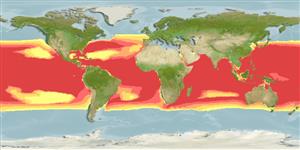Environment: milieu / climate zone / depth range / distribution range
Ecology
Marine; bathypelagic; oceanodromous (Ref. 51243); depth range 20 - 550 m (Ref. 13608). Deep-water; 49°N - 43°S, 180°W - 180°E
Atlantic, Indian and Pacific: tropical and warmer temperate waters. Western Atlantic: Massachusetts, USA and northern Gulf of Mexico to South America (Ref. 7251). Reported from southern Africa (Ref. 4412).
Size / Weight / Age
Maturity: Lm ? range ? - ? cm
Max length : 23.0 cm SL male/unsexed; (Ref. 48637)
Inhabits the open ocean (Ref. 26340). Found under floating weeds or debris. Adults were found under large weed-rafts at a depth of about 20 meters, using the shade as cover. They also form schools (Ref. 48637). Associated with Sargassum (Ref. 26340) and jellyfish (Ref. 7251).
Life cycle and mating behavior
Maturity | Reproduction | Spawning | Eggs | Fecundity | Larvae
Haedrich, R.L., 1986. Nomeidae. p. 846-850. In M.M. Smith and P.C. Heemstra (eds.) Smiths' sea fishes. Springer-Verlag, Berlin. (Ref. 4412)
IUCN Red List Status (Ref. 130435: Version 2024-1)
Threat to humans
Harmless
Human uses
Tools
Can't connect to MySQL database fbquizv2. Errorcode: Too many connections
